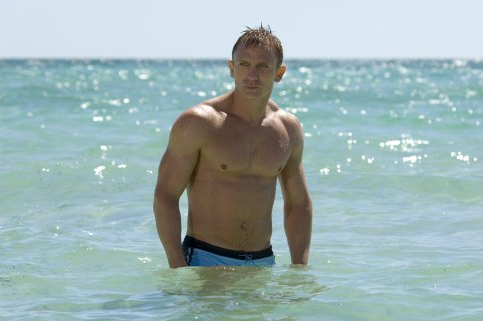james bond and the politics of gender
With the latest instalment now in cinemas, Kate Voss takes a look at the history and evolution of the Bond girl, and what it means to be a woman in James Bond’s universe.

This scene from Casino Royale was one of the first instances of James Bond being the subject of the female gaze – rather than the other way around.
Very few film franchises over the past fifty years have been more packed with more pure masculinity than the James Bond films. While these spy films revolve around one of the most debonair men in British history, they still cater to the action crowd, thrilling male audiences with explosions, fight scenes, and beautiful women. But how women are portrayed in these films says a lot about the world they were created in. Over the years, women in James Bond films have evolved in different ways, continually reflecting the political and social culture of our changing times.
One can’t have a Bond film without the quintessential Bond girl. She’s beautiful, seductive, and always ready to tangle with 007 – be it in bed, in a fight, or both. With names like Pussy Galore, Honey Rider, and Agent Triple X, these women were initially seen as little more than objects of sexual gratification for the male gaze. But beneath the layers of dripping sensuality, these female characters occasionally represented progress for women of 1960s. Honey Rider, known by many as the first real Bond girl in Dr. No, was a rape survivor who took revenge on her attacker through her own courage and resourcefulness. And Pussy Galore in Goldfinger ran her own crime ring (even though her sexuality was virtually erased in the film adaptation of the novel).
However, much of this progress took a step back in the 70s, mainly due to the cultural backlash against the second-wave feminist movement of the 60s. The worst offender is 1974’s The Man with the Golden Gun, which portrayed female agents as dim-witted bubbleheads in need of Bond’s saving and the main female adversary, Andrea Anders, as a scorned mistress who meets a dark demise. Not only were 70s Bond girl roles bland and sexist, they were diminished to a large degree, giving women less time onscreen in general.
By the 1980s, Bond girls started becoming more independent, and more like the characters from Ian Fleming’s novels. The film Octopussy was named after the powerful character herself, and in 1985, Grace Jones subverted the image of the waifish, femme fatale Bond woman with a strong, action-packed character in A View to Kill. Jones’ role as May Day went against the strict male-female gender binary seen in all of the previous Bond films, showing that the female villains in 007’s world could be just as physically powerful as the men.
The 1990s brought in a new perspective for the Bond films. This was a confusing time for the Bond girls, catching them between roles of power and roles of campy seduction. In 1995’s GoldenEye, Izabella Scorupco’s character is a talented computer programmer, but Famke Janssen’s character is a lusty seductress who crushes men with her thighs, showing the dichotomy of female characters. This was also an era when male viewers were outwardly skeptical of women who were both brainy and beautiful. Carmen Electra’s role in The World Is Not Enough was criticised for being unbelievable, as if a model could not play a professional, intelligent, a case of sexism coming from the audience rather than the filmmakers.
We’re now in a modern era of Bond girls who have their own unique strengths and flaws. 2002’s Die Another Day brought us the first black love interest in Halle Berry, and in a classic scene in Casino Royale, current 007 Daniel Craig slowly emerges from the ocean in a sexy shot not unlike that which Bond girls would have been subjected to in the past. The filmmakers, it seems, are finally aware that women are watching Bond films, too.
While there are still issues with how dispensable Bond girls can be (such as Sévérine in Skyfall), the women have much meatier, more meaningful roles than in years before, showing how far women have come in cinema generally. With Monica Belluci appearing in the franchise’s latest installment, Spectre, who knows what type of powerful, beautiful Bond girl we’ll see next and what it means for our generation of female characters.

